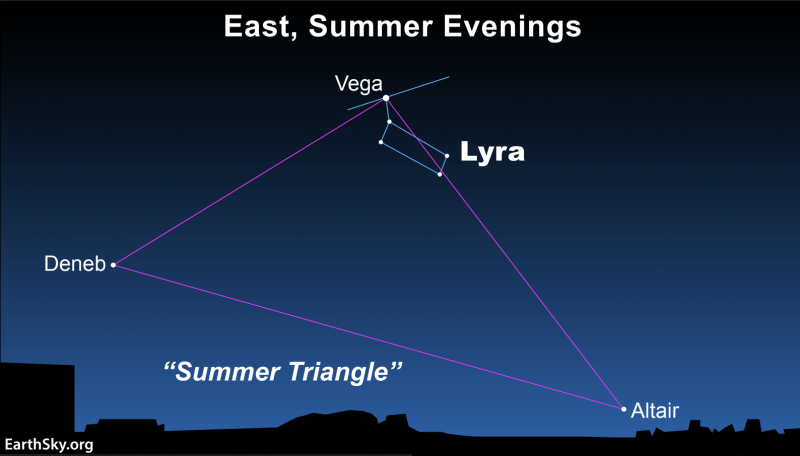Here's when July's full moon shines and how to spot the 'Summer Triangle' in Indiana
July is often filled with heavenly sights — fireworks, lightning from the occasional thunderstorm and the full Buck Moon, which charges across the summer sky toward the end of the month.
Skywatchers in July also should have a good view of Jupiter and the star Deneb, according to NASA. As one of the brightest stars in the constellation Cygnus, Deneb forms what astronomers call the "Summer Triangle." Here's where to find it and what we know about the moon's phases in July.
When is the next full moon in July 2024?
The Buck Moon shines its fullest Sunday, July 21, 2024. The moon's phases in July are:
?? New Moon: July 5.
?? First Quarter: July 13.
?? Full Moon: July 21.
?? Last Quarter: July 28.
Why is it called the Buck Moon?
It's around this time of year when a male deer's newly formed antlers begin to push out from the buck's head, according to the Old Farmer's Almanac. Other names for July's full moon from Native American tribes include the Salmon Moon, Thunder Moon, and Halfway Summer Moon.
When is the best time to see the full moon in July 2024?
For the Indianapolis area, moonrise will happen at roughly 9:53 p.m. Sunday, July 21, crossing the meridian at 2:43 a.m. before setting at 7:42 a.m. Monday.
You can check both moonrise and moonset times for your zip code by visiting the Old Farmer's Almanac online.
What is the 'Summer Triangle'?

Three shining stars — Deneb, Vega and Altair — form what's called the "Summer Triangle." This grouping is considered "an asterism," which means it's a simple, recognizable pattern of stars but not an official constellation. Skywatchers will note these three are among the brightest stars in the Northern Hemisphere, and can be spotted with relative ease, even in areas with light pollution.
The Summer Triangle serves as "stellar calendar," writes Astronomy publication EarthSky.org, heralding a change of seasons when the triangle becomes a familiar sight starting around mid to late June.
How to find the 'Summer Triangle'
To find the Summer Triangle, look toward the east at dusk after sunset and you'll likely spot Vega, shining blue and white as one of the brightest stars on July evenings. Vega is the top of the triangle.
Below Vega and to its right is Altair, which is 17 light-years away from Earth and about twice the mass and radius of the Sun, according to Space.com. Finishing the triangle is Deneb, which is below Vega but appears higher than Altair.
And once you find Deneb, congratulations, you've also found the tail of Cygnus, the swan constellation.
Why does the moon sometimes appear red?
You may have noticed the moon will occasionally take on a dramatic shade of orange or red in the night sky. That's because of how sunlight strikes the moon's surface after passing through our atmosphere.

When the moon moves into the inner part of Earth's shadow, or umbra, according to NASA, some of the sunlight entering Earth's skies scatters before reaching the moon's surface.
Colors with shorter wavelengths, such as blues and violets, scatter more easily than colors with longer wavelengths, which include red and orange. The more dust or clouds in Earth's atmosphere during a lunar eclipse, the redder the moon appears.
When is the next full moon of 2024?
The Sturgeon Moon is set to swim into the night sky Monday, Aug. 19, 2024.
Look up: Here's when every full moon shines in 2024
When was the last full moon?
The last full moon, known as the Strawberry Moon, reached peak illumination June 21.
2024 full moon names
Here's a list of the full moon names for 2024, courtesy of the Old Farmer's Almanac:
January: Wolf Moon
February: Snow Moon
March: Worm Moon
April: Pink Moon
May: Flower Moon
June: Strawberry Moon
July: Buck Moon
August: Sturgeon Moon
September: Corn Moon
October: Hunter Moon
November: Beaver Moon
December: Cold Moon
Almanac
Embedded content: https://www.almanac.com/sites/default/files/styles/or/public/image_nodes/full-moon-names-padding-2400px.png?itok=EXGfrJUC
Astronomical events happening in July 2024
Skywatchers, according to NASA, should keep the following dates in mind for July 2024.
? July 1: Jupiter and Saturn continue to shift westward as the lunar cycle continues, with Mars shifting more to the left. The waning moon will pass Mars on July 1, the Pleiades star cluster July 2, then Jupiter on July 3.
? July 5: New moon.
? July 13: First quarter. Mercury will shift to the left, low along the horizon, reaching its highest point above the horizon, about 2 degrees as twilight ends.
? July 21: Full moon. As twilight begins (at roughly 4:52 a.m. EDT), the setting full moon will be 7 degrees above the southwestern horizon. The brightest planet in the sky will be Jupiter at 25 degrees above the eastern horizon. Mars will be 33 degrees above the eastern horizon and Saturn 45 degrees above the southern horizon. The bright object appearing closest overhead will be the star Deneb at 56 degrees above the west-northwestern horizon.
? June 28: Last quarter of the moon.
John Tufts covers trending news for the Indianapolis Star. Send him a news tip at [email protected].
This article originally appeared on Indianapolis Star: When to see July 2024's full Buck Moon and Summer Triangle in Indiana

